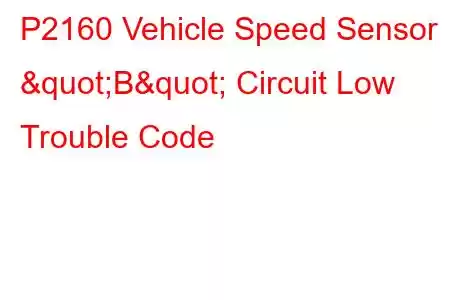P2160 Vehicle Speed Sensor B Low Input
OBD-II Trouble Code Technical Description
Vehicle Speed Sensor "B" Low Input
What does that mean?
This diagnostic trouble code (DTC) is a generic powertrain code, which means that it applies to all 1996-newer vehicles (Ford, Dodge, GMC, Chevy, etc.). Although generic, the specific repair steps may vary depending on make/model.
A stored code P2160 means that the powertrain control module (PCM) has detected a low voltage input signal from vehicle speed sensor (VSS) B. The designation B typically refers to the secondary VSS in systems which utilize multiple vehicle speed sensors.
Most vehicle speed sensors are electromagnetic sensors which utilize some type of toothed reluctor ring wheel or gear that is permanently affixed to an axle, transmission/transfer case output shaft, differential gear, or driveshaft. As the shaft spins, so spins the reluctor device which completes a circuit with the stationary electromagnetic sensor. As the reluctor passes in very close proximity to the electromagnetic tip of the sensor, the notches in the reluctor ring create interruptions in the sensor circuit. The combination of circuit completions and interruptions are received by the PCM (and other controllers) as wave form patterns representing voltage.
The PCM monitors vehicle speed using input data from one or more vehicle speed sensors and compares it to inputs from the antilock brake control module (ABCM) or electronic brake control module (EBCM). In some cases, secondary VSS input may be monitored using one or more wheel speed sensors but the primary VSS input (B) will likely be initiated by the VSS in the transmission.
If the PCM detects a low input voltage signal from the primary VSS, a code P2160 will be stored and a malfunction indicator lamp may be illuminated. A low voltage input condition may be caused by either an electrical or mechanical problem.
Code Severity & Symptoms
Since the conditions which may cause a P2160 code to be stored could create drivability and ABS issues, it should be classified as severe and addressed as quickly as possible.
Symptoms of a P2160 code may include:
Erratic speedometer/odometer operation Irregular transmission shift patterns Illumination of the service engine soon lamp, traction control lamp, or antilock brake lamp Unexpected activation/deactivation of the traction control system (if equipped) Other transmission and ABS codes may be stored The ABS system may be rendered inoperable in some casesCauses
Possible causes for this code include:
Excessive metal debris buildup on speed sensor/s A defective wheel speed or vehicle speed sensor Cut or otherwise damaged wiring harnesses or connectors (especially near speed sensors) Damaged or worn teeth on a reluctor ring A faulty PCM, ABCM, or EBCMDiagnostic and Repair Procedures
A diagnostic scanner, a digital volt/ohmmeter (DVOM), possibly an oscilloscope, and a reliable vehicle information source will be required when diagnosing a code P2160.
I normally like to begin my diagnosis of a P2160 with a visual inspection of system wiring, speed sensors, and connectors. Repair open or shorted circuits as required and clean excessive metallic debris from effected sensors. Check reluctor ring integrity when inspecting the sensor.
Connect the scanner to the vehicle diagnostic port and retrieve all stored trouble codes and available freeze-frame data. Before clearing the codes, write this information down as it may prove helpful as your diagnosis progresses.
Using your vehicle information source, search applicable technical service bulletins (TSB). If you locate a TSB that matches the symptoms and stored codes of the vehicle in question, the diagnostic information contained therein will likely aid in diagnosing the P2160 from here.
Utilize the scann
Read: 21


